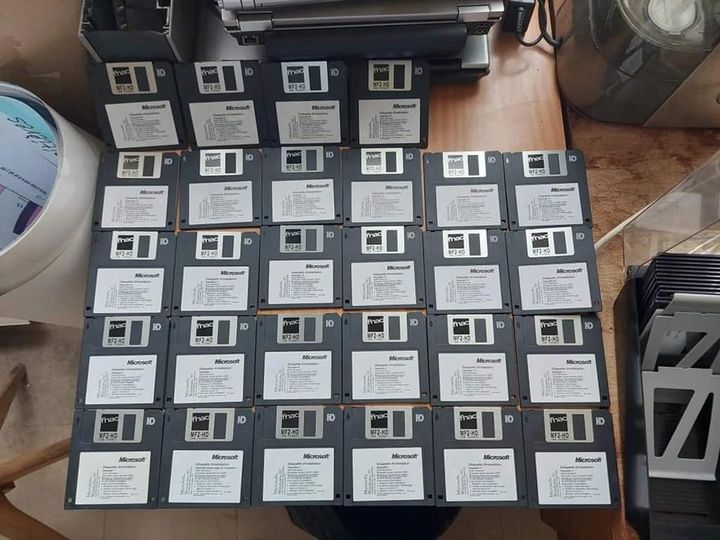The pain/struggle was real to install Windows 95 – 28 Install 3.5 install disks back then.
Bill Gates announced Microsoft Windows on November 10, 1983. Microsoft introduced Windows as a graphical user interface for MS-DOS, which had been introduced two years earlier. The product line evolved in the 1990s from an operating environment into a fully complete, modern operating system over two lines of development, each with a separate codebase.
The first versions of Windows (1.0 through to 3.11) were graphical shells from MS-DOS. Windows 95, though still based on MS-DOS, was its operating system, using a 16-bit DOS-based kernel and a 32-bit user space. Windows 95 also had a significant 16-bit code ported from Windows 3.1. Windows 95 introduced many features that have been part of the product ever since, including the Start menu, the taskbar, and Windows Explorer (renamed File Explorer in Windows 8). In 1997, Microsoft released Internet Explorer 4, which included the (at the time controversial) Windows Desktop Update. It aimed to integrate Internet Explorer and the web into the user interface. It also brought many new features into Windows, such as displaying JPEG images as the desktop wallpaper and single window navigation in Windows Explorer. In 1998, Microsoft released Windows 98, including the Windows Desktop Update and Internet Explorer 4 by default. The inclusion of Internet Explorer 4 and the Desktop Update led to an antitrust case in the United States.
Windows 98 included USB support out of the box and plug-and-play, allowing devices to work when plugged in without requiring a system reboot or manual configuration. Windows Me, the last DOS-based version of Windows, was aimed at consumers and released in 2000. It introduced System Restore, Help and Support Center, updated versions of the Disk Defragmenter, and other system tools.
In 1993, Microsoft released Windows NT 3.1, the first version of the newly developed Windows NT operating system. “NT” is an acronym for “New Technology.” Unlike the Windows 9x series of operating systems, it is a fully 32-bit operating system. NT 3.1 introduced NTFS, a file system designed to replace the older File Allocation Table (FAT) used by DOS and the DOS-based Windows operating systems. In 1996, Windows NT 4.0 was released, which includes a fully 32-bit version of Windows Explorer explicitly written for it, making the operating system work like Windows 95. Windows NT was initially designed to be used on high-end systems and servers. Still, with the release of Windows 2000, many consumer-oriented features from Windows 95 and 98 were included, such as the Windows Desktop Update, Internet Explorer 5, USB support, and Windows Media Player.
These consumer-oriented features were further extended in Windows XP in 2001, which included a new visual style called Luna, a more user-friendly interface, updated versions of Windows Media Player and Internet Explorer 6 by default, and extended features from Windows Me, such as the Help and Support Center and System Restore. Windows Vista, released in 2007, focused on securing the operating system against computer viruses and other malicious software by introducing features such as User Account Control. New features include Windows Aero, updated versions of the classic games (e.g., Solitaire), Windows Movie Maker, and Windows Mail to replace Outlook Express. Despite this, Windows Vista was critically panned for its poor performance on older hardware and its at-the-time high system requirements. Windows 7 followed in 2009, nearly three years after its launch, and despite it technically having higher system requirements, reviewers noted that it ran better than Windows Vista.
Windows 7 removed many applications, such as Windows Movie Maker, Windows Photo Gallery, and Windows Mail, instead requiring users to download separate Windows Live Essentials to gain some of those features and other online services. Windows 8, which was released in 2012, introduced many controversial changes, such as the replacement of the Start menu with the Start Screen, the removal of the Aero interface in favor of a flat, colored interface as well as the introduction of “Metro” apps (later renamed to Universal Windows Platform apps). The Charms Bar user interface element received considerable criticism from reviewers. Windows 8.1, a free upgrade to Windows 8, was released in 2013.
The following version of Windows, Windows 10, released in 2015, reintroduced the Start menu and added the ability to run Universal Windows Platform apps in a window instead of always in full screen. Windows 10 was generally well-received, with many reviewers stating that Windows 10 is what Windows 8 should have been.
The latest version of Windows, Windows 11, was released on October 5, 2021. Windows 11 incorporates a redesigned user interface, including a new Start menu, a visual style featuring rounded corners, and a new layout for the Microsoft Store. It also includes Microsoft Edge by default.
